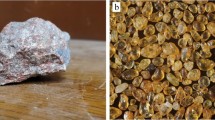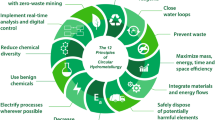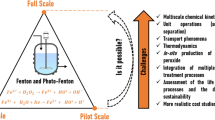Abstract
Electrolytic reduction (ER) of hematite (Fe2O3) can serve as a low-direct-emissions production method for powder ferrometallurgy against traditional blast furnace (BF) and direct reduction (DR) methods. Use of ER in these contexts will also allow for valorization of hematite-rich waste feeds such as red mud. This study performs a techno-economic analysis on a low-temperature aqueous ER technology to determine the value of the process and its products at a scale of 100,000 tons red mud processed per year. The study is performed under several electricity pricing scenarios, for which the material, energy, economic, and emissions impacts are developed and compared to incumbent technologies. Monte Carlo simulations were performed to account for uncertainties surrounding variable feedstock composition and process parameters. It was found that hematite content and conversion rate were the most sensitive variables, followed by electricity pricing. The iron powder product has an expected minimum selling price of ~ $1450/ton when operating on feeds with ~ 50 wt% Fe2O3, under processes with ~ 66 mol% conversion and ~ 70% Faradaic efficiency. The studied electricity sources had minimal impact on iron selling price, but renewable electricity sourcing significantly undercuts carbothermic process emissions. Because of the high cost and small scale relative to bulk iron manufacture, this process could find a niche in valorizing red mud to produce a high-quality iron powder for additive manufacturing or powder metallurgy industries in addition to reducing red mud causticity and promoting downstream purification of the outlet stream.
Graphical Abstract







Similar content being viewed by others
References
Renzulli P, Notarnicola B, Tassielli G, Arcese G, Di Capua R (2016) Life cycle assessment of steel produced in an italian integrated steel mill. Sustainability 8(8):719. https://doi.org/10.3390/su8080719
Winkler D, Bidló A, Bolodár-Varga B, Erdó Á, Adrienn H (2018) Long-term ecological effects of the red mud disaster in Hungary: regeneration of red mud flooded areas in a contaminated industrial region. Sci Total Environ 644:1292–1303. https://doi.org/10.1016/j.scitotenv.2018.07.059
Sadoway DR (1995) New opportunities for metals extraction and waste treatment by electrochemical processing in molten salts. J Mater Res 10(3):487–492. https://doi.org/10.1557/JMR.1995.0487
Ramakgala C, Gwiranai D (2019) A review of ironmaking by direct reduction processes: quality requirements and sustainability. Procedia Manufacturing 35(2019):242–245. https://doi.org/10.1016/j.promfg.2019.05.034
Allanore A (2014) Features and challenges of molten oxide electrolytes for metal extraction. J Electrochem Soc 162(1):13–22
Wang D, Gmitter AJ, Sadoway DR (2011) Production of oxygen gas and liquid metal by electrochemical decomposition of molten iron oxide. J Electrochem Soc 158(6):E51. https://doi.org/10.1149/1.3560477
Allanore A, Yin L, Sadoway DR (2013) A new anode material for oxygen evolution in molten oxide electrolysis. Nature 497(7449):353–356. https://doi.org/10.1038/nature12134
Kim H, Paramore JD, Allanore A, Sadoway DR (2020) Stability of iridium anode in molten oxide electrolysis for ironmaking: influence of slag basicity. In: Proceedings of the 218th ECS Meeting, 2010. Las Vegas, pp 219–230. https://doi.org/10.1149/1.3484779
Wang Q, Zhu Y, Wu Q, Gratz E, Wang Y (2015) Low temperature electrolysis for iron production via conductive colloidal electrode. RSC Adv 5(8):5501–5507. https://doi.org/10.1039/C4RA14576C
Allanore A, Lavelaine H, Valentin G, Birat JP, Lapicque F (2008) Iron metal production by bulk electrolysis of iron ore particles in aqueous media. J Electrochem Soc 155(9):E125. https://doi.org/10.1149/1.2952547
Maihatchi A, Pons M-N, Ricoux Q, Goettmann F, Lapique F (2020) Electrolytic iron production from alkaline suspensions of solid oxides: compared cases of hematite, iron ore and iron-rich Bayer process residues. J Electrochem Sci Eng 10:95. https://doi.org/10.5599/jese.751
Sevasti Koutsoupa SK, Bourbos E, Balomenos E, Panias D (2021) Electrolytic iron production from alkaline bauxite residue slurries at low temperatures. Johnson Matthey Technol Rev 65(3):366–364. https://doi.org/10.1595/205651320X15918757312944
Home | Siderwin. https://www.siderwin-spire.eu/
Fischedick M, Marzinkowski J, Winzer P, Weigel M (2014) Techno-economic evaluation of innovative steel production technologies. J Clean Prod 84:563–580
Kalamaras CM, Efstathiou AM (2013) Hydrogen production technologies: current state and future developments. Conf Papers Energy 2013:690627. https://doi.org/10.1155/2013/690627
HYBRIT Fossil-Free Steel (2018) SSAB, LKAB and Vattenfall
Mendicino L, Menniti D, Pinnarelli A, Sorrentino N (2019) Corporate power purchase agreement: formulation of the related levelized cost of energy and its application to a real life case study. Appl Energy 253:113577. https://doi.org/10.1016/j.apenergy.2019.113577
Climate Neutral Research Campuses—Power Purchase Agreements. National Renewable Energy Laboratory. https://www.nrel.gov/climate-neutral/power-purchase-agreements.html
Allanore A, Lavelaine H, Birat JP, Valentin G, Lapicque F (2010) Experimental investigation of cell design for the electrolysis of iron oxide suspensions in alkaline electrolyte. J Appl Electrochem 40(11):1957–1966. https://doi.org/10.1007/s10800-010-0172-0
Narasimhan KS (2001) Sintering of powder mixtures and the growth of ferrous powder metallurgy. Mater Chem Phys 67(1):56–65. https://doi.org/10.1016/S0254-0584(00)00420-X
Simchi A (2004) The role of particle size on the laser sintering of iron powder. Metall Mater Trans B 35(5):937–948. https://doi.org/10.1007/s11663-004-0088-3
Khairul MA, Zanganeh J, Moghtaderi B (2019) The composition, recycling and utilisation of Bayer red mud. Resour Conserv Recycl 141:483–498. https://doi.org/10.1016/j.resconrec.2018.11.006
Giesen H, Hibbel J, Jansen W, Speth S Separation of carbon black by liquid hydrocarbons. US4107036A
George Zheng Chen DF, Farthing T (2000) Direct electrochemical reduction of titanium dioxide to titanium in molten calcium chloride. Nature 407(6802):361–364. https://doi.org/10.1038/35030069
Den Hond R, Hiralil I, Rijkeboer A (2007) Alumina yield in the Bayer process: past, present, and prospects.In Donaldson D, Raahauge B.E. (eds) Essential readings in light metals. https://doi.org/10.1007/978-3-319-48176-0_73
Chase MW (1998) NIST-JANAF Thermochemical Tables. Journal of Physical and Chemical Reference Data Monograph 9
Ma L-C, Castro-Dominguez B, Ma YH, Kazantzis N (2015) Integration of membrane technology into hydrogen production plants with CO2 capture: An economic performance assessment study. Int J Greenhouse Gas Control 42:424–438. https://doi.org/10.1016/j.ijggc.2015.08.019
Ma L-C, Castro-Dominguez B, Kazantzis NK, Ma YH (2016) A cost assessment study for a large-scale water gas shift catalytic membrane reactor module in the presence of uncertainty. Sep Purif Technol 166:205–212. https://doi.org/10.1016/j.seppur.2016.04.019
Peters M, Timmerhaus K, West R (2002) Plant design and economics for chemical engineers, 5th edn. McGraw-Hill, New York
Zhu Y, Snowden-Swan LJ, Hallen RT, Hart TR, Bearden MD, Liu J, Seiple TE, Albrecht KO, Jones SB, Fox SP, Schmidt AJ, Maupin GD, Billing JM, Elliott DC (2017) Conceptual biorefinery design and research targeted for 2022: hydrothermal liquefaction processing of wet waste to fuels. Pacif Northwest Natl Lab 27186:89. https://doi.org/10.2172/1415710
Organic Chemical Process Industry (1983) Carbon black. United States Environmental Protection Agency
Australia’s Energy Production, Consumption and Exports. Geoscience Australia. https://www.ga.gov.au/scientific-topics/energy/basics
Australia Renewables. Australian Government Department of Industry, Science, Energy and Resources. https://www.energy.gov.au/data/renewables
Kopsakangas-Savolainen M, Mattinen M, Manninen K, Nissinen A (2017) Hourly-based greenhouse gas emissions of electricity—cases demonstrating possibilities for households and companies to decrease their emissions. J Clean Prod 153:384–396. https://doi.org/10.1016/j.jclepro.2015.11.027
Batan L, Graff G, Bradley T (2016) Techno-economic and Monte Carlo probabilistic analysis of microalgae biofuel production system. Biores Technol 219:45–52. https://doi.org/10.1016/j.biortech.2016.07.085
Yang Y, Wang Y, Yang SH (2008) Design of a networked control system with random transmission delay and uncertain process parameters. Int J Syst Sci 39(11):1065–1074. https://doi.org/10.1080/00207720802085286
Acknowledgements
The authors are grateful to Prof. Nikolaos Kazantzis for assistance with Monte Carlo cost modeling methodology.
Author information
Authors and Affiliations
Corresponding author
Ethics declarations
Conflict of interest
The authors declare that they have no conflict of interest.
Additional information
The contributing editor for this article was Christina Meskers.
Publisher's Note
Springer Nature remains neutral with regard to jurisdictional claims in published maps and institutional affiliations.
Supplementary Information
Below is the link to the electronic supplementary material.
Rights and permissions
About this article
Cite this article
Shahabuddin, M., Powell, A.C. & Wang, Y. Preliminary Economic Analysis of Red Mud Valorization via Colloidal Aqueous Electrolytic Reduction in a Modern Electricity Infrastructure. J. Sustain. Metall. 8, 900–912 (2022). https://doi.org/10.1007/s40831-022-00537-5
Received:
Accepted:
Published:
Issue Date:
DOI: https://doi.org/10.1007/s40831-022-00537-5




